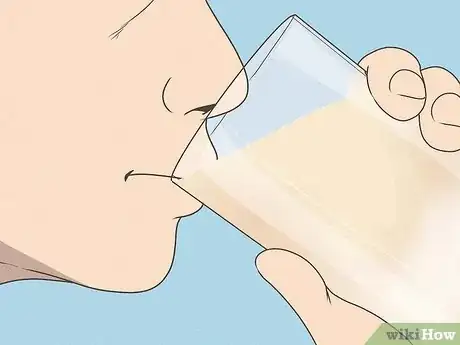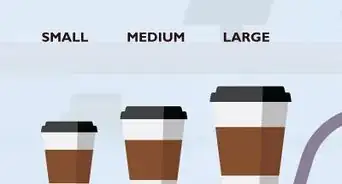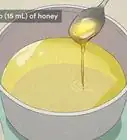This article was co-authored by wikiHow staff writer, Johnathan Fuentes. Johnathan Fuentes is a writer based in the New York City region. His interests as a writer include space exploration, science education, immigration, Latinx cultures, LGBTQ+ issues, and long-form journalism. He is also an avid hiker and has backpacked in Alaska and Newfoundland, Canada. A son of Cuban immigrants, he is bilingual in English and Spanish. Prior to joining wikiHow, he worked in academic publishing and was a freelance writer for science websites. He graduated from Columbia University in 2021, where he studied nonfiction writing and wrote for the student newspaper. He is currently counting down the seconds until the release of Kerbal Space Program 2 in 2023—a game that will almost certainly take up what little free time he has.
There are 15 references cited in this article, which can be found at the bottom of the page.
Learn more...
Have you ever been in line at a coffee shop on a hot summer day and wondered, “Should I get an iced latte or an iced coffee?” What’s the difference, exactly? Though they look similar, these two coffee shop staples are siblings, not twins. They’re made with different ingredients, and if you taste them side by side, you can definitely tell them apart. This article explains how iced lattes and iced coffees are different. Read on to learn how they’re made, which is healthier, and which to use for your next caffeine fix.
Things You Should Know
- Iced lattes are made with espresso, milk, and ice. Some people add sweeteners and other flavors too, like chocolate or caramel.
- Iced coffees are made with conventional coffee and ice. Some people add milk, sugar, or other flavors.
- Iced lattes taste richer and creamier than iced coffee. This is because lattes are mostly milk, while coffee usually contains a small amount of milk, or none at all.
- Both iced lattes and iced coffees can be high in calories, especially if you order large sizes or add sugar. However, iced coffees usually have more caffeine.
Steps
How Iced Coffees and Iced Lattes are Made
-
1An iced latte is made with espresso (plus, milk and ice too). An espresso machine pressurizes water, heats it, and “pulls” it through a special blend of finely-ground coffee beans. If done correctly, the espresso should be creamy and thick, with a small amount of foam on top.[1] The espresso is quickly combined with ice and milk, and that's how you make an iced latte.[2]
- Some people enjoy adding other ingredients to iced lattes, including sweeteners, chocolate, and caramel, among many other options.
- Lattes are traditionally served hot. In this case, the milk is steamed until it gets foamy. The steamed milk is then poured over freshly-pulled espresso to make a latte.[3]
-
2An iced coffee, on the other hand, is made from regular coffee. The raw coffee beans are harvested, roasted, and ground. Then, in most cases, one of two things happens: either hot water is poured over the ground beans, or the ground beans are soaked in cold water overnight.[4]
- When hot water is used, the beans release flavors into the water, creating hot coffee, which can then be poured over ice.[5] When cold water is used, the beans slowly release their flavors over several hours, creating cold coffee that is collected and served the next day.
- Many people add milk, sugar, and other ingredients to their coffee. This can make the coffee look like a latte, but regular coffee contains much less milk than a latte.
- You can make cold brew in tons of exciting ways. You can even add coffee-infused ice cubes to your brew!
References
- ↑ https://pages.uoregon.edu/chendon/publications/2020/74.%20Matter,%20Espresso%20extraction.pdf
- ↑ https://youtu.be/S3qoxUWpYcQ?t=79
- ↑ https://www2.gvsu.edu/millsp/Types%20of%20Coffee.html
- ↑ https://www.thekitchn.com/big-batch-cold-brew-coffee-257177
- ↑ https://scribe.usc.edu/the-history-of-iced-coffee/
- ↑ https://baristahq.com/latte-vs-coffee/
- ↑ https://www.roastycoffee.com/coffee-espresso/
- ↑ https://www.roastycoffee.com/best-roast-for-cold-brew/
- ↑ https://www.roastycoffee.com/light-roast-vs-dark-roast/
- ↑ https://www.roastycoffee.com/best-roast-for-cold-brew/
- ↑ https://www.urmc.rochester.edu/encyclopedia/content.aspx?contenttypeid=76&contentid=19868-1
- ↑ https://www.dunkindonuts.com/content/dam/dd/pdf/nutrition.pdf
- ↑ https://www.fatsecret.com/calories-nutrition/generic/sugar?portionid=26063&portionamount=1.000
- ↑ https://www.hsph.harvard.edu/nutritionsource/caffeine/
- ↑ https://www.realsimple.com/food-recipes/shopping-storing/beverages/starbucks-debunked-espresso-amounts
- ↑ https://www.ncbi.nlm.nih.gov/pmc/articles/PMC8228209/

























































